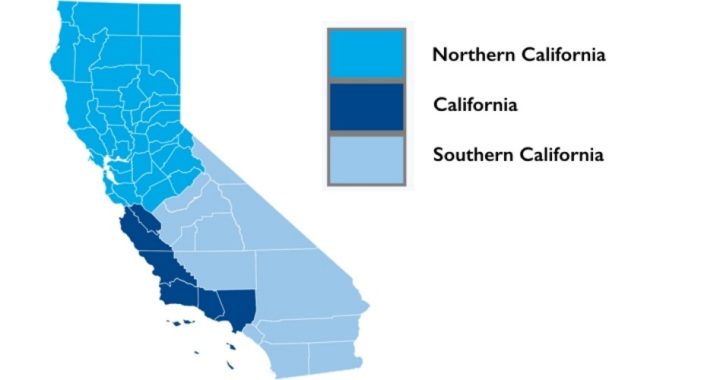
Come November, California voters will be able to vote on a ballot initiative that proposes to partition their state into three separate states: California, Northern California, and Southern California. Under the proposed plan, the new “California” would be dominated by Los Angeles, “Northern California” would be dominated by San Francisco, and “Southern California” would be dominated by San Diego.
On June 12, the office of California Secretary of State Alex Padilla certified that a sufficient number of voter signatures had been gathered for the ballot initiative, making the measure eligible to appear on the ballot for the general election on November 6, 2018. If the “Three Californias” initiative is approved by voters, the actual division of the state would not happen automatically. The initiative calls on California’s governor to ask the U.S. Congress to carry out the division. Article IV, Sec. 3 of the U.S. Constitution reads: “New States may be admitted by the Congress into this Union; but no new State shall be formed or erected within the Jurisdiction of any other State; nor any State be formed by the Junction of two or more States, or Parts of States, without the Consent of the Legislatures of the States concerned as well as of the Congress.”
The initiative itself claims that approval by the state legislature is not necessary because the initiative fulfills the role of the legislature. That, to say the least, is a dubious claim that certainly would be challenged in court. However, the Democrat-controlled California legislature might actually favor the initiative’s goal, if it should pass. In that case, the ball would be passed to Congress.
What would division of our most populous state mean for the rest of the country? Ballotpedia offers this evaluation of the impact on federal elections: “Partitioning California into three states would increase the size of the U.S. Senate from 100 to 104 members and divide the state’s 55 (as of 2018) electoral points between three states. The new states of California and Northern California would be considered safe Democratic states, based on current voting trends, whereas Southern California would be considered competitive between Democrats and Republicans, according to Geoffrey Skelley of Sabato’s Crystal Ball.” Ballotpedia quotes Skelley as saying, “Splitting California into thirds would put about one-third of the state’s electoral votes in play for the GOP, while the additional Senate seats might benefit the Democrats.”
That’s two states and four Senate seats, along with most of the congressional and Electoral College votes, that would be delivered to “safe” Democrat strongholds, while the other two Senate seats would be “in play.” Which is another way of saying that the new Southern California and its two Senate seats would have a chance of being Republican — at least for a while, until the continuing influx of illegal aliens could be organized as a voting block to vote the Democrats in.
The Three Californias (CAL 3) initiative is the brainchild of billionaire Tim Draper, a Silicon Valley venture capitalist who has bankrolled the efforts with millions of his own dollars. In 2014 he launched a similar effort to divide the state into six states, but it failed to make it onto the ballot.
In an April 11, 2018 press release, Draper stated: “CAL 3 is committed to solving California’s most pressing issues, including the state’s failing school systems that impact more than 6 million kids, highest-in-the-nation taxes, deteriorating infrastructure and strained government. Partitioning California into three states would empower regional communities to make better, fairer and more sensible decisions for their citizens.”
Much of Draper’s CAL 3 rhetoric is aimed at co-opting support of political conservatives, many of whom may see this as a last-ditch chance to salvage an escape from the Democrat-imposed approaching doom. However, the main failure of CAL 3 is that its designers have sculpted the proposed new states in such a way that the less-populated rural counties will be perpetually at the mercy of the big coastal cities, which are controlled by far-Left Democrats. The small cities and towns and farming, ranching, mining, timber communities of northern, central, and southern parts of the state will continue to be steamrolled by the big city political machines.
It is outrage over this unfair political misrepresentation that has fueled the movement for the State of Jefferson, which proposes to create the 51st State from 23 counties of northern California. The intended State of Jefferson would differ markedly from the proposed CAL 3 State of Northern California, most noticeably in that it would not include the San Francisco-Bay Area, Sacramento, or other liberal-left urban enclaves included in the CAL 3 proposal. The State of Jefferson (SOJ51) proposal is one that might give the currently over-taxed, over-regulated, unrepresented citizens of California’s northern counties a real chance at self governance, liberty, and prosperity. Unshackled from the political powers in Sacramento, and with its bountiful natural resources, the State of Jefferson could provide a side-by-side test showcasing the costs and benefits of two different systems of government. Which is why the California state legislature is unlikely ever to give its approval to the SOJ51 measure.
Map: Wikipedia Commons/Mliu92
Related articles:
New California Law May Punish Pastors for Helping Others Leave Homosexuality
Newsom, Cox Top California’s Jungle Primary in Race for Governor
California’s New Water Laws Institute Draconian Limits on Water Usage
High-income Earners Leaving High-tax States
California Bill Would Criminalize Speech, Books Opposing LGBT Agenda
Homeschoolers Turn Out in Droves to Defeat Intrusive California Bill



